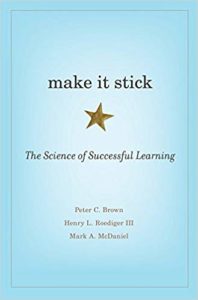Make it Stick: The Science of Successful Learning
During the Christmas break, it was great to finally get around to reading Make it Stick: The Science of Successful Learning by Peter C. Brown, Henry L. Roediger III and Mark A. McDaniel.

The book, which explores the science behind successfully retaining information, had been in my pile of ‘must-reads’ for a long time.
It has many relevant takeaways, which we thought we’d share here. The first being some key concepts to consider when designing a learning experience or course:
Interleaving
Interleaving is a method of introducing a new concept, then layering in additional ideas.
When using this technique, it’s important to vary your content by switching between concepts and revisiting them in intervals. Spacing the content out and repeatedly revisiting ideas will help learners recall the information and embed it firmly in their brains.
The authors neatly demonstrate this technique by revisiting the concept of interleaving throughout the book.
Effort = retention
The authors provide evidence that learning is deeper and more durable when it requires effort.
In the e-learning industry, there’s often a desire to make things easy for students and help them work through the content effortlessly (often when related to compliance topics). This idea has never sat well with us – is the aim to finish or to acquire new information that sticks?
Remember the last time you made a big leap in your abilities or knowledge? You’ll probably recall it was quite challenging at the time, but ultimately the rewards reflect the effort.
The ‘illusion of knowing’
It’s common for learners to ‘not know what they don’t know’, i.e. believe they fully understand something, when in fact, they don’t.
This false sense of mastery can be overcome through critical feedback, either from a teacher or coach (we suspect an online diagnostic tool could also fit the bill in certain circumstances).
Ineffective learning methods
The book also goes to some length to outline several learning techniques that are commonly seen as effective, even though they’ve been widely disproven.
A common example I’ve seen (and done myself) is cramming. On the bus to work recently, I’ve noticed lots of teenage students with their heads buried in their textbooks, preparing for their latest exam. To get the information to sink in, they’re revisiting their notes over and over. Perhaps unsurprisingly, the book suggests this is an ineffective way of retaining information in the long term (whether they want to remember this information later, or just pass their exam, is a discussion for another day!).
In the same vein, the authors argue that practising the same skill for hours on end until it’s mastered is essentially ineffective, as it’s not the number of hours that counts, it’s what’s done in those hours.
So, what can we do as course designers to make our learning experiences more effective?
Focus on active learning methods
Rather than simply reading text or watching videos, encourage your students to reflect on what they’ve learnt. This could be done in the form of a blog or a sketchnote for example. This seems a rather elementary and obvious point, but always worth reiterating.
Don’t make it too easy
As the book suggests, it can be useful to create ‘desirable difficulties’. One way to do this is through generative learning; where learners are presented with a problem to solve before being introduced to the concepts or method. This way, they need to put more effort into searching for a solution.
Use low-stakes testing methods (e.g. multiple-choice quizzes) frequently (but only as a reinforcement aid)
We think multiple-choice quizzes suck as an assessment method (as they were simply designed to make grading easier), but they can be useful reinforcement aids when crafted carefully!
Use interleaving to incorporate concepts throughout the course, ideally in a variety of contexts
Remember to allude to each concept throughout to build up a foundation of knowledge. Rather than simply separating each concept into its own chunk, create a learning experience that references the concepts as you journey through it.
—
We hope this has given you some ideas to help your students get the most out of your learning experiences or courses. Check out this YouTube summary of Make it Stick for a more detailed view (alternatively just buy the book or visit the companion Make it stick website):
Fresh insights direct to your inbox
Join the Candle Digital mailing list




